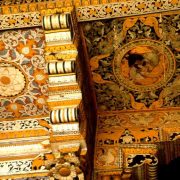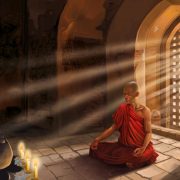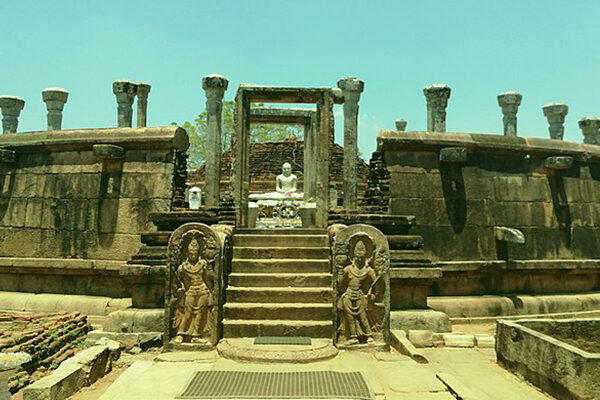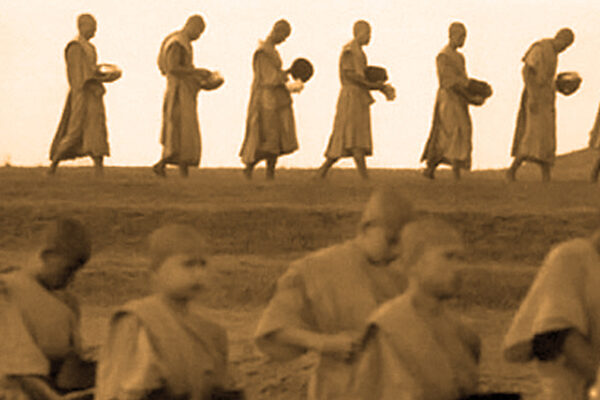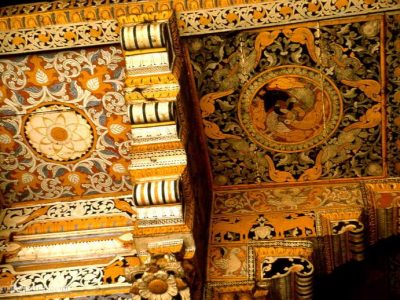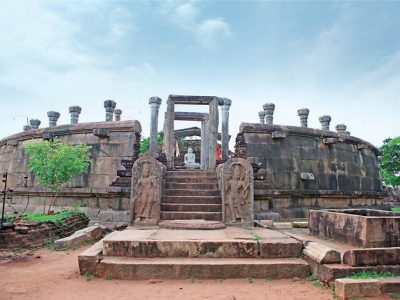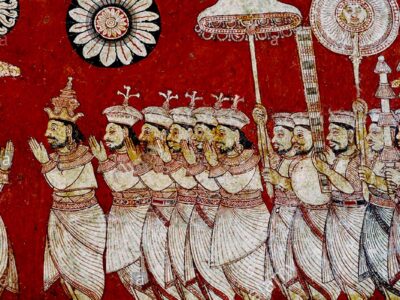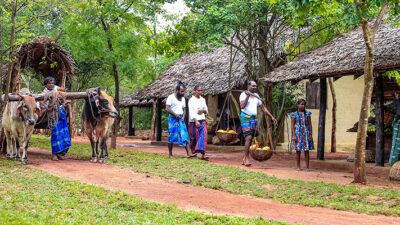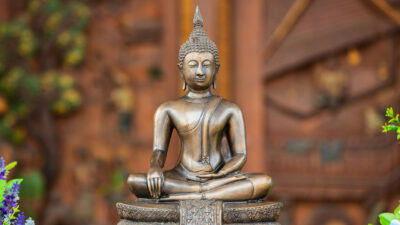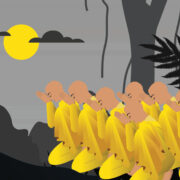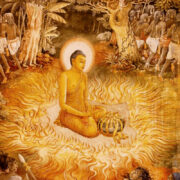BUDDHISM in its initial phase accommodated and synthesized certain pre-Buddhistic beliefs. Thus, the pre-Buddhistic tree worship as well as the veneration of the stupas in which the corporeal remains of important personalities were deposited and absorbed into Buddhist culture. In fact, a new meaning to pre-Buddhistic symbols was attached and the stupa Bodhi symbols represented symbols of acculturation.
The Mahaparinibbana Sutta recommends the worship of places associated with the Buddha’s birth, enlightenment, inaugural sermon and demise. The stupa in which relics of the Buddha were enshrined and the Bodhi or Asvatta tree under which the Buddha attained enlightenment were usually located close to each other and became two important symbolic places of worship for the Buddhist community.
The Dipavamsa, Mahavamsa, Samantapasadika and several other chronicles and literary works refer to the dispatch of the southern sapling of the Bodhi tree at Gaya by the emperor Asoka through Sanghamitta to Sri Lanka during the reign of Devanampiyatissa. Thera Mahinda and the retinue who had come to Jambukolapatana from Anuradhapura received the sacred object with great honour. After a series of sacred festivals on the sea-shore as well as at a spot where the Pacinarama or the Eastern Monastery was established in Nagadipa, the sacred object was taken to Anuradhapura in a beautifully decorated chariot.
Around the high terrace in which the sapling of the Bodhi tree was planted, a bodhighara or a shrine had been developed in subsequent centuries with railings as well as an outer wall enclosing the complex structures in the compound. The outer wall contained four entrances as four cardinal points. As Paranavitana has pointed out, later developments however, have swept away all ancient features, and the Bodhi shrine at Anuradhapura as it exists today may not contain any vestige of the architecture of the third, second and first centuries BC and the early centuries of the Christian era.
The chronicles provide information about the constructions and restorations at the Bodhi shrine by different monarchs, the earliest work after Devanampiya Tissa being that of the great tank builder Vasabha (67-111 AD). Vasabha added a temple in the courtyard of the Bodhi tree with statues and placed stone pillars surmounted by dharmacakras at three of the four entrances and in the southern entrance set up a stone throne.
The Bodhi tree was in very close proximity to an adjunct of the Mahavithara, the main monastic complex at Anuradhapura. But the tree was sacred to all sects. When Mahasena (274 – 301) destroyed monasteries such as the Lohapasada or the Brazen Palace of the Mahavihara fraternity, sacred site of the Bodhi tree was spared. Irrespective of Mahasena’s attitude of persecution of the Mahavihara monks, and supporting the other sects he built a temple for the Bodhi tree. Thus even if the Mahavihara was abandoned for nine years during Mahasena’s reign, one can arrive at a conclusion that the ritual importance of the sacred Bodhi tree continued uninterruptedly. When the Mahavihara was rebuilt, Mahasena made two bronze images and set them up on the west side of the temple of the great Bodhi tree.
Between the fourth and the tenth centuries AD, several kings restored or made improvements to the complex of structures at the sacred Bodhi tree at Anuradhapura. For instance, Sirimeghavanna (301-328) built a stone terrace and a wall beside the Bodhi tree. The account of Fa-hien, the Chinese Scholar monk who visited Anuradhapura during the reign could sustain the tree. Besides, this could be a continuation of a tradition which embodies the belief that watering a sacred tree could cause rains to fall during periods of drought. The key figures involved in the ritual of watering were the bhikkunis. The Mahakalattava inscription datable to the reign of Kassapa IV (899-914) records a decree of amnesty granted to a village called Gitelgamu (va) which had been set apart for the supply of four fold requisites to the nuns who daily watered the great Bodhi tree of the Mahavihara. The bhikkhunis were from a nunnery called naparama which was presumably located close to the Bodhi tree. According to the practice of this nunnery, seven of the chief bhikkuhunis were entrusted, with the task of daily watering the Bodhi tree. The Kalinga Bodhi Jataka enumerates the honours that could be bestowed on the Bodhi tree as bathing the tree, offering flowers, lighting lamps, hanging garlands, hoisting flags and banners, burning incense, placing vases of plenty or punnaghata, sprinkling the Bodhi compound with sand, playing ritual music and circumambulation.
When the centre of political authority shifted to Polonnaruwa, the sacred centres at Anuradhapura do not seem to have received the same degree of attention and patronage and the Bodhi is mentioned as one of the three important sacred centres at Anuradhapura, the other two being the Thuparama and Ruvanweli Seya. An inscription found at the Ruwanweli Chetiya datable to her reign refers to offerings of camphor, lamps and banners of these centres and to pious monks living in monasteries associated with them.
Once the capital had been removed from Polonnaruwa to Dambadeniya and subsequently to Yapahuva, the Sinhala monarchs were not in a position to maintain the sacred centres at Anuradhapura or even at Polonnaruwa. According to the Culavamsa Vijayabahu IV (1270-1272) of Yapahuwa went to Anuradhapura and cleared the forest growth around Thuparama and appointed a Chief Thero of the Senantha Parivena Thera to look after the restoration of the Ratnavali Chetiya. Subsequently he entrusted the protection of the city of Anuradhapura to Vanni chieftains and proceed to Polonnaruwa. This would indicate that when the Rajarata civilization began to wither away in the middle of the thirteenth century, the Vanni Chieftains who assumed authority over the isolated pockets of settlements there, were entrusted with the task of maintaining the sacred centres at Anuradhapura, whether their human and material resources. Perhaps the history of the Srimaha Bodhi in the fourteenth, fifteenth, sixteenth and seventeenth centuries has to be viewed as the history of the preservation of the tree as well as the continuation of the ritual therein by these dedicated monks.
During the period of Kandyan kings, the most important centres of ritual were the Temple of the Tooth in Kandy, the Mahiyangana Thupa and the Sumanakuta or the Adams Peak. Several kings including Vimaladhammasooriya II (1687-1707) and Sri Vira Parakrama Narendrasinghe (1707-1739) have made pilgrimages to Mahiyangana Thupa and the Sumanakuta. Nevertheless, Anuradhapura had not completely lost is importance. For instance, Narendrasinghe went to Anuradhapura to make offerings and Sri Vijayarajasingha (1739-1747) celebrated religious festivals both at Mahiyangana and Anuradhapura. Kirthi Sri Rajasingha (1742-1782) went with his retinue to Anuradhapura to participate in rituals at the Bodhi tree, and granted the Bodhi tree and the sacred Chetiyas elephants, horses, gold and silver.
The rituals of the sacred Bodhi were not as complex as in the days of the Kandyan kings as it had been in the Anuradhapura period. The same importance was given to the protection of the tree. The chasing away of crows was considered as important as it had been earlier and a group of archers, who were provided with maintenance land, were entrusted with that task. The Service Tenure Registers of 1870/71 throw some light on the assignment of land for services rendered to the sacred Bodhi tree in the nineteenth century. Obviously the allocation of land was done by the Kandyan Kings earlier. Major Forbes who visited the former city of kings in the first few decades of the nineteenth century, states that all the ruins at Anuradhapura, even the lofty monuments which contained the relics of the Buddha, were either entirely covered with jungle or were partly obscured by the forest. The only place clear of jungle was in front of the Mahavihara. During his time, the court of the Bodhi tree or Jayasirimaha Bodin Vahanse had an enclosure of three hundred and fifty five feet in length and two hundred and sixteen in breadth. Within the walls were the principalization programmes in the Dry Zone in the first part of the twentieth century, the precincts of the Bodhi tree, received greater attention than in the nineteenth century. Once independence has been gained, there was more interest both over Buddhist clergy and the political leaders in the improvement of the sacred precincts.
Prof. W. I. Siriweera
Former Vice Chancellor, Rajarata University


